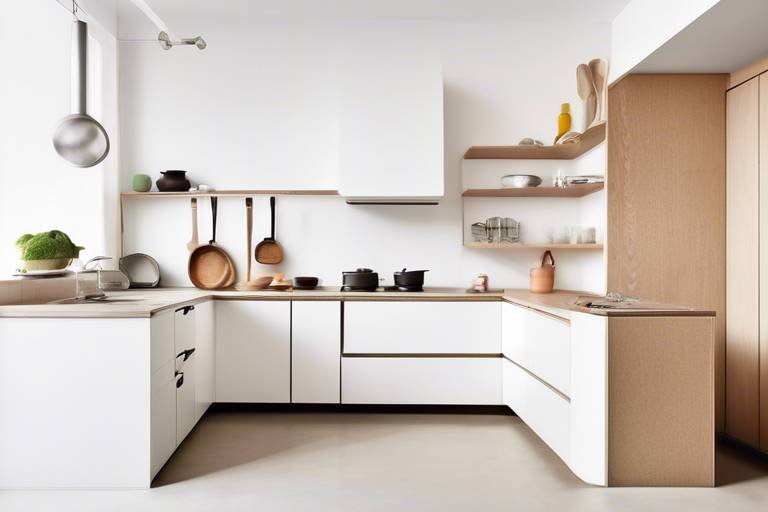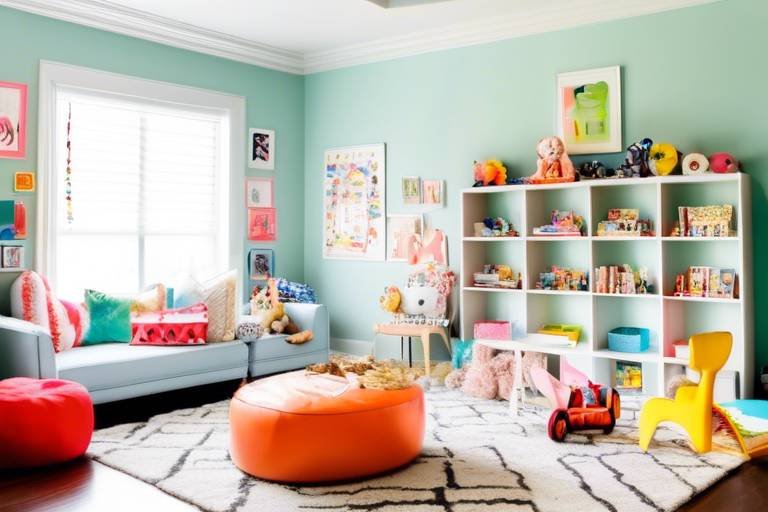Tips for Using Color and Texture to Define Different Spaces
When it comes to designing a space, the use of color and texture plays a crucial role in defining different areas and creating a cohesive visual experience. By strategically incorporating these elements, you can transform a room into a dynamic and inviting environment that reflects your personal style and enhances the functionality of the space.
Color psychology is a fascinating aspect of design that explores how different colors can evoke various emotions and influence our perception of a space. Warm tones like red and yellow can create a sense of energy and warmth, while cool hues such as blue and green are known for their calming and soothing effects. Understanding the psychological impact of colors can help you choose the right palette to set the desired mood in each area of your home.
When selecting a color scheme, consider the overall atmosphere you want to achieve. Whether you opt for a monochromatic scheme for a minimalist look or a complementary color palette for a vibrant feel, each choice can define a specific space within your home. Harmonious combinations create a sense of unity, while contrasting elements add visual interest and depth.
Textures are another powerful tool in interior design, adding tactile qualities that can elevate the sensory experience of a room. From plush fabrics to rough surfaces, incorporating a variety of textures can bring depth and character to your space. Mixing smooth and rough textures can create a dynamic contrast that engages the senses and adds visual intrigue.
To ensure a seamless transition between different areas, creating visual flow is essential. By using color and texture to establish a cohesive design language throughout your home, you can guide the eye from one space to another effortlessly. Consistency in color tones and texture choices helps maintain a sense of harmony and unity in your overall design.
Focal points are key elements in any room that draw attention and anchor the design. By accentuating these focal points with strategic color and texture choices, you can highlight their importance and create visual impact. Whether it's a bold accent wall or a statement piece of furniture, using color and texture to enhance focal points can elevate the overall aesthetic of your space.
Patterns are versatile design elements that can be used to define different areas and add visual interest. From geometric prints to floral motifs, patterns can inject personality and style into a room. When integrating patterns, consider the scale and placement to ensure they complement the overall design scheme without overwhelming the space.
By carefully considering the functional aspects of color and texture, you can enhance the usability of your space while maintaining its aesthetic appeal. Practical considerations such as durability and maintenance should guide your choices, ensuring that the design not only looks good but also supports your lifestyle. Whether it's choosing stain-resistant fabrics or easy-to-clean surfaces, incorporating functionality into your design can make your space both beautiful and practical.
Personalizing your living environment is a reflection of your unique tastes and preferences. By infusing color and texture choices that resonate with you, you can create spaces that feel truly personal and inviting. Whether it's a pop of your favorite color or a texture that speaks to your sense of comfort, incorporating elements that reflect your personality can turn a house into a home.

Understanding Color Psychology
Understanding Color Psychology is essential in creating a harmonious and visually appealing space. Colors have the power to evoke emotions, influence perceptions, and set the overall tone of a room. Warm tones like red and yellow can create a cozy and energetic atmosphere, while cool tones like blue and green promote calmness and relaxation. By understanding the psychological impact of colors, individuals can strategically choose hues that resonate with the intended mood of each space.
Color psychology goes beyond personal preferences; it taps into universal reactions to colors. For example, red is often associated with passion and energy, while blue conveys tranquility and trust. By incorporating these insights into interior design, one can effectively create spaces that not only look visually appealing but also evoke specific feelings and emotions in occupants.
Moreover, different colors can affect spatial perception. Light colors can make a room feel more spacious and airy, while dark colors can add coziness and intimacy. By playing with color tones and contrasts, designers can manipulate the perceived size and shape of a space, ultimately enhancing its functionality and aesthetic appeal.

Choosing a Color Scheme
When it comes to defining different spaces within a room, choosing the right color scheme plays a crucial role. Colors have the power to evoke emotions, set the tone, and create a specific atmosphere. By understanding the psychology behind colors, you can effectively select hues that resonate with the desired ambiance.
One essential aspect to consider when choosing a color scheme is the concept of harmony. Harmonious color schemes involve colors that are adjacent to each other on the color wheel, creating a sense of cohesion and tranquility. On the other hand, contrasting color schemes use colors that are opposite each other on the color wheel, adding vibrancy and visual interest to a space.
Another factor to keep in mind is the purpose of the space. Different colors can evoke different feelings and serve various functions. For instance, warm tones like reds and oranges can create a cozy and intimate atmosphere, perfect for a living room or bedroom. In contrast, cool tones such as blues and greens can promote calmness and concentration, ideal for an office or study area.
When selecting a color scheme, it's also essential to consider the natural light in the room. Natural light can affect how colors appear, so it's crucial to test samples in the actual space to see how they look under different lighting conditions. Additionally, don't forget to take into account the existing furnishings and decor in the room to ensure that the color scheme complements the overall design aesthetic.

Playing with Textures
When it comes to designing a space, textures play a crucial role in adding depth and character, elevating the overall aesthetic appeal. By incorporating a variety of textures, you can create a sensory experience that is both visually stimulating and engaging to touch. Imagine walking into a room where smooth silk curtains contrast with a rough brick wall, creating a dynamic interplay that captivates the senses.
Textural elements can range from soft and plush fabrics to rough and rugged surfaces, each contributing to the tactile experience within a space. By playing with textures, you can evoke different emotions and moods, transforming a plain room into a rich and inviting environment. Think of how a cozy knitted throw placed over a sleek leather sofa can instantly add warmth and comfort to a living area.
Furthermore, textures can also help define specific areas within a space, delineating zones for different functions or activities. For instance, using a shaggy rug in a reading nook can create a cozy retreat, while a sleek marble countertop in the kitchen can convey a sense of sophistication and elegance. By strategically selecting and layering textures, you can visually segment a room while maintaining a cohesive design scheme.
Experimenting with textures allows you to infuse personality and creativity into your space, showcasing your unique style and preferences. Whether you prefer the rustic charm of weathered wood or the modern sleekness of polished metal, textures provide a canvas for self-expression and individuality. By mixing and matching different textures, you can curate a space that reflects your personal taste and creates a welcoming atmosphere for both residents and guests.

Creating Visual Flow
Creating visual flow in a space is essential for ensuring a cohesive and harmonious design aesthetic. By strategically using color and texture, you can guide the eye seamlessly from one area to another, creating a sense of continuity and unity throughout the space. Imagine a river meandering through a landscape, effortlessly connecting different parts of nature. Similarly, color and texture can act as the guiding elements that lead occupants through a space, creating a visually pleasing journey.
One effective way to establish visual flow is by using a consistent color palette throughout the space. This doesn't mean everything has to be the same color, but rather that there should be a unifying theme that ties the different areas together. For example, you could use varying shades of blue in different parts of a room, creating a sense of cohesion while still allowing for visual interest and variety.
Texture also plays a crucial role in creating visual flow. By mixing different textures, such as smooth surfaces with rough ones or shiny materials with matte finishes, you can add depth and dimension to the space. This variation in texture helps guide the eye across the room, preventing it from becoming stagnant or monotonous.
Another technique for enhancing visual flow is through the strategic placement of focal points. By using color and texture to draw attention to specific areas, such as a statement wall or a unique piece of furniture, you can create natural stopping points that encourage movement throughout the space. Think of these focal points as landmarks that help navigate the visual journey within the room.

Accentuating Focal Points
When it comes to designing a space, **accentuating focal points** can truly elevate the overall aesthetic. By strategically using color and texture, you can draw the eye to specific areas and create a sense of visual interest. Imagine walking into a room where a vibrant accent wall immediately captures your attention, or a luxurious textured rug that becomes the centerpiece of the space.
One effective way to **highlight focal points** is by **contrasting** them with the surrounding elements. For example, if the majority of the room features a neutral color palette, introducing a bold pop of color to the focal point can make it stand out even more. Similarly, playing with different textures such as smooth surfaces against rough ones can create a dynamic visual impact.
**Lighting** also plays a crucial role in accentuating focal points. By strategically placing **light fixtures** or utilizing natural light, you can emphasize certain areas and create a sense of drama. Imagine a well-lit piece of artwork against a dimly lit background, instantly drawing attention to its beauty and significance.
Moreover, **artwork** and **decorative elements** can serve as focal points themselves. By carefully selecting pieces that resonate with the overall design theme and incorporating them into the space, you can create visual anchors that tie the room together. Whether it's a striking sculpture, a statement piece of furniture, or a unique wall hanging, these items can become the focal points that define the character of the space.
Remember, **accentuating focal points** is not about overwhelming the space with too many elements competing for attention. It's about **strategically** choosing key areas to highlight and using color and texture to guide the viewer's gaze. When done effectively, accentuating focal points can create a sense of balance and harmony within the space, making it visually engaging and inviting.

Utilizing Patterns
When it comes to defining different spaces within a room, the use of patterns can play a crucial role in creating visual interest and delineating areas effectively. Patterns can range from bold and striking geometric designs to subtle and intricate motifs, each contributing to the overall aesthetic of the space in a unique way.
By strategically incorporating patterns into the design scheme, you can add a layer of complexity and charm to the space, enhancing its visual appeal and creating a sense of depth. Patterns can be used on various elements such as textiles, wallpapers, rugs, or even architectural details to define different zones and add a touch of personality to the room.
When utilizing patterns, it's essential to consider the scale and proportion of the design in relation to the size of the space. Larger patterns can make a bold statement and draw attention, while smaller patterns can create a more subtle and refined look. Mixing different patterns can also add a dynamic and eclectic vibe to the space, but it's crucial to ensure that they complement each other harmoniously.
Moreover, patterns can be used to guide the eye and create a sense of movement within the space. By strategically placing patterns in key areas, you can direct the flow of the room and emphasize specific features or focal points. Whether through repetitive motifs or intricate designs, patterns can help define different areas and enhance the overall visual impact of the space.

Enhancing Functionality with Color and Texture
Enhancing functionality with color and texture goes beyond mere aesthetics; it involves a thoughtful approach to design that considers both visual appeal and practicality. By strategically utilizing color and texture, spaces can be optimized to serve their intended functions effectively.
One way to enhance functionality is by using color psychology to create environments that promote productivity, relaxation, or social interaction. For example, warm tones like red and orange can energize a workspace, while cool blues and greens are calming choices for a bedroom or living area.
In terms of texture, selecting materials that are both visually pleasing and tactile can greatly improve the usability of a space. For instance, choosing soft, plush fabrics for seating areas can enhance comfort and coziness, while smooth, easy-to-clean surfaces are ideal for high-traffic areas.
When it comes to defining different areas within a space, utilizing contrasting textures can help delineate zones and create visual interest. Pairing rough textures with smooth ones or mixing matte finishes with glossy surfaces can add depth and dimension to a room, making it more engaging and dynamic.
Additionally, considering the functionality of each area when selecting colors and textures is crucial. For instance, using durable, stain-resistant materials in dining areas or children's playrooms can ensure that the space remains both visually appealing and easy to maintain, enhancing its longevity and usability.
By carefully balancing color and texture to enhance functionality, spaces can be transformed into not only visually stunning environments but also practical and efficient ones that cater to the needs and activities of their inhabitants.

Personalizing Spaces
Personalizing spaces through color and texture choices is a powerful way to create environments that truly reflect individual personality and style. By carefully selecting colors that resonate with personal preferences and textures that evoke specific emotions, one can transform a generic space into a unique and personalized oasis. Imagine walking into a room that instantly feels like a reflection of your inner self, with colors that uplift your spirit and textures that invite touch and exploration. It's like wearing a tailored suit that fits perfectly, enhancing your confidence and comfort in your own skin.
Frequently Asked Questions
- Can color and texture really make a difference in defining spaces?
Yes, color and texture play a crucial role in defining spaces by creating visual interest, setting the mood, and enhancing the overall design aesthetic. By strategically using different hues and tactile elements, you can transform a space and make it more inviting and engaging.
- How can I choose the right color scheme for different areas?
When selecting a color scheme, consider the purpose of the space, the desired ambiance, and the existing decor elements. You can opt for harmonious color combinations for a cohesive look or experiment with contrasting colors to create a bold statement. It's essential to balance the colors to achieve the desired effect.
- What role do textures play in defining spaces?
Textures add depth, warmth, and personality to a space. By incorporating different textures such as rough, smooth, soft, or shiny, you can create visual and tactile interest. Textures also help in breaking the monotony and making the space more dynamic and engaging.
- How can I personalize my living space using color and texture?
Personalizing a space involves infusing your unique style and preferences through color and texture choices. You can showcase your personality by selecting colors that resonate with you and incorporating textures that reflect your taste. Experimenting with different combinations allows you to create a space that truly feels like home.



















